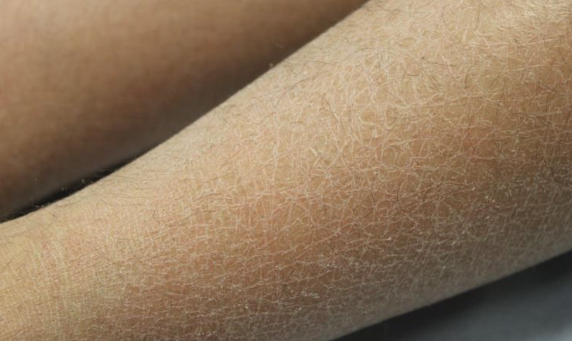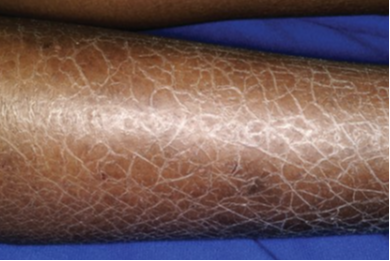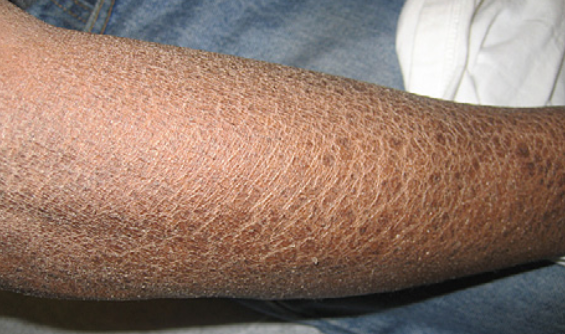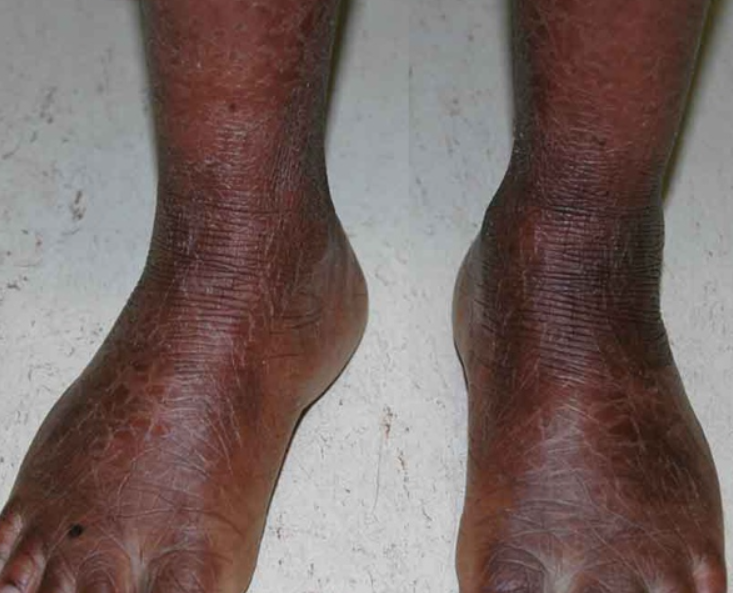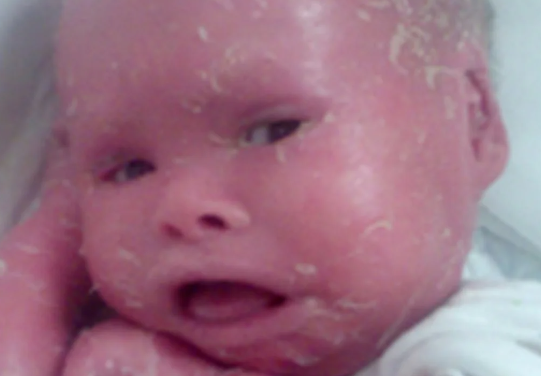Ichthyosis (from the Greek "ichthys" meaning fish) is an inherited skin disorder characterized by diffuse keratinization disorder resembling hyperkeratosis. ICD-10 Code: Q80.
Ichthyosis vulgaris (autosomal dominant ichthyosis, ichthyosis simplex): Characterized by autosomal dominant inheritance with incomplete penetrance and variable expressivity. The major genetic defect is in the expression of the keratohyalin granule protein profilaggrin. Polymorphisms in genes on chromosome 1q22 have been identified. Mutations in the profilaggrin gene (R501X and 2282del4) have been identified. The involvement of multiple genes, one of which affects profilaggrin expression, cannot be excluded. Filaggrin deficiency leads to reduced levels of free amino acids in the stratum corneum of the epidermis, resulting in the skin dryness seen in patients with ichthyosis vulgaris. The prevalence of the disease in the population is 1:250 (in adolescents) and 1:5300 (in adults).
X-linked ichthyosis: Characterized by recessive X-linked inheritance. The genetic defect involves mutations in the sterol sulfatase gene located at Xq22.32. Deficiency of this enzyme leads to accumulation of excess cholesterol sulfate in the epidermis, increased adhesion of keratinized scales, and persistent hyperkeratosis. The prevalence of the disease in the population is 1:2000-1:9500. It affects only males.
Lamellar Ichthyosis (Collodion Baby): May be inherited as either an autosomal recessive or autosomal dominant trait. In some cases, mutations in the gene encoding transglutaminase keratinocytes (chromosome 14q11) are detected, resulting in a defect in the structure of the cornified layer cells. The prevalence of the disease in the population is 1:200,000-1:300,000.
Bullous Ichthyosiform Erythroderma (Epidermolytic Ichthyosis): Autosomal dominant inheritance is seen in about half of cases. In the remaining cases, there is only one proband in the pedigree. Linkage to 12q11-13 and 17q12-q21 (mutations in the keratin genes K1 and K10) has been identified. The prevalence of the disease in the population is 1:300,000.
Ichthyosis of the Newborn (Harlequin ichthyosis): Characterized by autosomal recessive inheritance with complete penetrance of the gene and variable expression ranging from moderate to severe clinical manifestations. The frequency of occurrence in the population is 1:300,000.
Other congenital ichthyoses: This group includes a number of syndromes in which ichthyosis is one of the symptoms: Netherton syndrome, Rud syndrome, Sjögren-Larsson syndrome, Young-Fogarty syndrome, linear verrucous epidermal nevus syndrome (Comel-Netherton syndrome).
Ichthyosis Vulgaris
The main clinical features of this disorder are scaling, increased wrinkling of the palms and soles, and follicular hyperkeratosis. Scaling is most pronounced on the extensor surfaces of the limbs, with less involvement of the skin on the back, abdomen, and scalp. The scales are predominantly small, thin, with wavy edges, and range in color from white to dark gray to brown. The shins have the darkest and thickest scales, which are polygonal in shape and tightly packed. Follicular hyperkeratosis, in the form of small dry nodules at the hair follicle openings, is observed on the thighs, shoulders, forearms, and buttocks, and may also be localized on the trunk and face. Palpation of the affected areas reveals a "grating" sensation. The palms and soles have an accentuated pattern, increased wrinkling, giving them an aged appearance. Painful cracks often appear on the soles during the summer.
Nail plates are brittle and often break from the free edge, sometimes leading to onychohysis. Hair becomes thin and sparse.
Expression of ichthyosis vulgaris is variable. Abortive forms of the disease occur, characterized by dry skin with mild scaling and increased wrinkling of the palms and soles.
The disease is characterized by the following signs:
- Presence of ichthyosis in the patient's first and second degree relatives.
- Clinical symptoms appearing within the first year of life (3-7 months) or later (up to 5 years).
- Clear seasonality with improvement in summer and worsening of clinical manifestations in winter.
- Association with allergic diseases: Individuals with vulgar ichthyosis are prone to allergies and atopy. The frequency of co-occurrence with atopic dermatitis reaches 40-50%. Concurrent manifestations of bronchial asthma, vasomotor rhinitis and urticaria are common. Food and drug intolerance is typical.
- Associations with gastrointestinal diseases (gastritis, enterocolitis, biliary dyskinesia) are seen, with cryptorchidism or hypogenitalism observed in a minority (3% of patients). Patients are susceptible to bacterial, viral and fungal infections.
X-linked ichthyosis
Dryness of the skin is observed immediately after birth or in the first weeks of life. Later, light and dark brown scales appear on the extensor surfaces of the limbs. The nape of the neck has a "dirty" appearance due to the accumulation of scales. The armpits, elbow creases, and genitalia are unaffected. A distinguishing feature from other forms of ichthyosis is the absence of skin involvement on the face and hands, resembling "gloves".
The disease is characterized by the following signs:
- Presence of ichthyosis in 1st and 2nd degree relatives of the patient. Only males are affected. Females are heterozygous carriers of the defective gene without clinical manifestations of the disease.
- Clinical symptoms appear at birth or in the first weeks of life.
- Slight seasonality, with most patients noticing an improvement in skin condition during the summer.
- Absence of associations with atopic dermatitis and respiratory atopy in most patients.
- Corneal opacity without visual impairment (in 50% of patients), cryptorchidism (in 20% of patients)
Lamellar Ichthyosis
Characterized by generalized lamellar scaling, always accompanied by palmoplantar hyperkeratosis, a constant clinical sign of the disease. Scales on smooth skin are usually small and light, while on the shins they are larger and form lamellar scales. Some patients may have deformity of the auricles.
The disease is characterized by the following signs:
- Presence of ichthyosis in the patient's 1st and 2nd degree relatives.
- Clinical symptoms appear from birth: the infant is born with a collodion membrane or in a state of generalized erythroderma, followed by the development of generalized lamellar scale about 6-7 months after birth.
- Absence of physical and mental developmental disorders in patients.
- Absence of seasonality.
Bullous ichthyosiform erythroderma
Hyperkeratosis with large keratinized plates is observed in the areas of large natural skin folds (knees, elbows, wrists, ankles, neck folds, and axillae). The hyperkeratotic patches are brown, brown-black, or dirty gray in color. On the background of hyperkeratosis, vesicles with serosanguineous contents initially appear, followed by secondary infection. At the same time, there is an increase in body temperature and enlargement of regional lymph nodes. When the keratinized layers are sloughed off, eroded areas with prominent papillary growths remain. Unpleasant odor is common due to frequent secondary infections.
The disease is characterized by the following signs:
- Presence of ichthyosis in the patient's 1st and 2nd degree relatives.
- Clinical symptoms appear from birth: the infant's skin appears macerated at birth, soon after birth it becomes dry, and in the large natural folds it becomes thickened and coarsely folded.
- Seasonal exacerbation of the disease: the appearance of blisters and subsequent infection usually occurs in the fall and spring.
Harlequin Ichthyosis
The condition affects the entire skin, forming a continuous, variable-thickness stratum corneum of whitish-yellow or grayish-brown color that cracks and forms deep furrows on the joint surfaces. The head of the patient has a thick layer of horny deposits with short, sparse or absent hair. The mouth is wide open due to pronounced infiltration of the soft tissues, with deep fissures at the corners. The lips are thickened, the mucous membranes are turned outwards, there is a pronounced ectropion and sparse eyelashes. The ears are deformed and pressed tightly against the skull or turned forward. The nostrils and auditory canals are lined with keratinous, plug-like deposits.
The disease is characterized by the appearance of clinical symptoms from birth: at birth, the baby's skin resembles a rough, dry horny shell of grayish white or purple color that darkens within the first few hours after birth. In 80% of cases, newborns are premature.
- Acquired ichthyosis
- Keratosis pilaris
- Acrodermatitis Enteropathica
- Atopic eczema
- Asteoatotic eczema
- Netherton syndrome
Treatment Goals
- Improvement of skin condition.
- Enhancement of the patient's quality of life.
General Treatment Considerations
- Given the variability of the clinical manifestations of vulgar ichthyosis, treatment is prescribed according to the severity of the clinical symptoms.
- In mild forms of the disease, only topical therapy and balneological procedures(low evidence) may be used.
Ichthyosis Vulgaris
Systemic therapy
For severe scaling and dryness of the skin, oral retinol is prescribed at a dose of 3500-6000 IU per kg of body weight per day for 7-8 weeks, then the dose is reduced by half. Repeat courses may be given every 1-4 months.
Topical therapy
Keratolytic agents: products containing 2-5% or 10% urea, 2-5% salicylic acid, 8% lactic acid and 2% glycolic acid applied twice daily during therapy and between courses. Emollients and moisturizers: ergocalciferol cream, 0.5% retinol ointment, oil-in-water creams applied 2-3 times daily between treatments. Alkaline soap should not be used for washing.
Balneological treatment (low evidence):
Salt baths at 35-38°C with a concentration of 10 g/L sodium chloride, duration 10-15 minutes, followed by application of 10% salt cream with lanolin and fish oil on the skin. Baths with sea salt, starch (1-2 cups per bath), bran, baking soda, chamomile infusion (38°C), duration 15-20 minutes. Sulfide baths of moderate intensity (0.1-0.4 g/L), 36-37°C, duration of 8-12 minutes (for a course of 12-14 baths); oxygen baths at a pressure of 2.6 kPa (36°C), duration of 10-15-20 minutes.
X-linked ichthyosis
Systemic therapy:
Retinol 6000-8000 IU per kg body weight orally per day for 8 weeks, with as low a maintenance dose as possible. Repeat courses of retinol palmitate may be given every 3-4 months. Acitretin 0.3-0.5 mg per kg of body weight orally per day for a total treatment duration of at least 6-8 weeks, with gradual dose reduction to the minimum effective dose.
Topical therapy and balneological treatment(low evidence) are similar to those for ichthyosis vulgaris.
Lamellar ichthyosis
Acitretin 0.3-0.5 mg per kg of body weight orally with subsequent maintenance treatment and dose reduction by 2-3 times. The duration of treatment varies from 2-3 months to one year. Recurrence occurs on average 6 weeks after discontinuation of treatment. The combination of synthetic retinoids with phototherapy increases the efficacy of treatment.
Congenital bullous ichthyosiform erythroderma
Acitretin 0.3-0.5 mg orally per kg body weight. Aromatic retinoids may increase skin fragility, potentially exacerbating the bullous component. Topical regenerative agents are recommended to accelerate healing of erosions.
Harlequin Ichthyosis
Neonates require intensive therapy in the incubator. Parenteral correction of water and electrolyte balance is necessary, as is the use of systemic antibacterial agents. Severe forms of congenital ichthyosis require systemic therapy. Treatment should be initiated within the first days of life. Therapeutic measures include systemic glucocorticosteroid administration based on prednisolone at a dose of 2-5 mg per kg of body weight per day for 1-1.5 months, with gradual dose reduction until complete discontinuation.
Skin care includes moisturizing, healing fissures and preventing infection. The use of keratolytics and mechanical removal of keratinous layers is not recommended.
Prevention
There are no preventive methods. Limit exposure to allergenic substances in household chemicals, detergents, cosmetics, animal furs, and synthetic materials.

